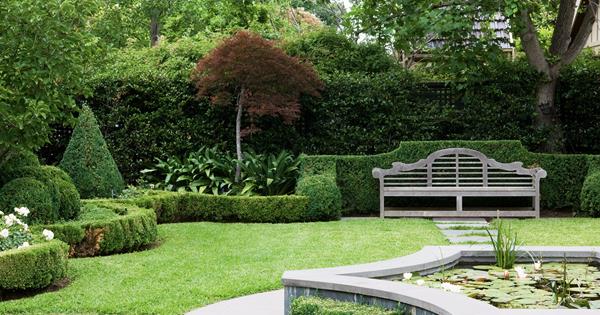
Formal gardens are as popular today as any other time for backyard designs, especially if it is separated into different garden rooms.
A formal garden is a garden laid out with symmetry. It is very ordered and, as the name says, formal. Clipped edges played a large part in formal gardens of the past and still look grand today.
A formal garden may seem intimidating, but it is really just a different style. There are several easy landscaping ideas to help you establish and maintain a formal look. The trick is to keep your flowers and shrubs trim and contained inside clearly marked flower beds.
Mark out and measure your flower bed before you start. If the edges are straight, you can use stakes and string to guide your shovel when digging it over. If curved, then use a garden hose as a guide.
Formal gardens are often raised and at least have to edge to keep the symmetrical look. If using grass, then it needs to be kept trim and weed-free and edged. Edging, whether straight or curved, is a focal point of formal gardens. You can choose self propelled mowers that offer the best trimming options for your garden.
Formal gardens often have arbors, trellises, and gates made of wrought iron and brick, which are traditional materials used. Many formal gardens have sculptures or traditional benches as a focal point.
Suitable plants for formal gardens include shrubs that can be trimmed regularly. Repeating shapes along pathways and standards are good selections.
Many colorful plants can be clipped and trimmed to fit the formal look—everything in its place and neat and tidy.
Garden edging plays a very important role in differentiating between whether to call a garden formal or not. So, we will look into in-depth detail on garden edging here.
Garden edging is used to define a line between your beds and the lawn. It can be an important part of landscape design.
Landscape Edging Materials
Stone
Stone makes your garden have a more formal appearance or a more rustic look, depending on how you lay it. Use the same stone for any walkways.
Plastic
This edging is the easiest to install and the least expensive also. Make sure you choose a durable plastic to last longer and look better.
Brick
Brick edging has been used in many gardens, and the variety of ways it is used to divide your garden can often add to the style of gardens you are after.
A formal look is just as easy to achieve as that country garden look just by choosing the color and style of brick along with the design of edging.
Recycled Rubber
As an edging, it will curve with your garden and is available in different depths, so it is ideal.
This may not actually be an edging material, but old tires that have been recycled into mulch mats will stop the grass from encroaching on your garden. Laying it at the very front of the garden, you will be able to mow over it without any problem.
Recycled Rubber and Aluminium are two edgings that can create tree rings, curved beds, and a variety of other shapes because of their flexibility.
Polypropylene “Decorative Stone” Edging
This is made of high-density polypropylene and looks like natural stone. The pieces interlock and make it easy to install.
There are many edgings to choose from, and these are just a few here. To choose the right one for your gardens, think of what you are trying to achieve. Go with the theme of your backyard. A little thought now will help you avoid large maintenance jobs in the future.
Do you want your edging to stand out or blend in? What is your budget for the edging? If you make the answers to these questions a part of your overall plan for your backyard, then it will make life easier when it comes time to create your garden





